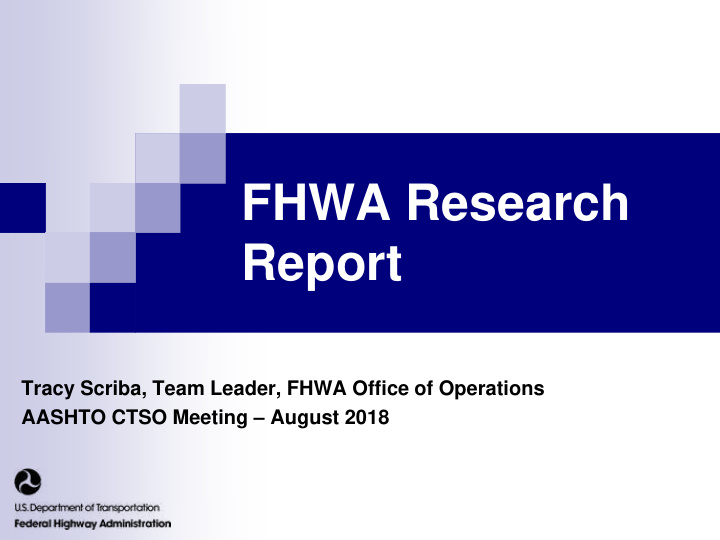



FHWA Research Report Tracy Scriba, Team Leader, FHWA Office of Operations AASHTO CTSO Meeting – August 2018
Operations Program Operations Research Highlights Active Transportation and Demand Management (ATDM) Work Zone Management Strategic Highway Research Program (SHRP2) Establishing a Strong Foundation for TSMO Performance Measures and Management Freight Asset Management 2
ATDM Dynamic Part-Time Shoulder Use Follow-up to FHWA Guide on Part-Time Shoulder Use https://ops.fhwa.dot.gov/publications/fhwahop15023/ New project to develop a “playbook” to assist agencies with decisions on when to open and close dynamic shoulders. Synthesis of current practice complete, playbook methodology underway. 3
ATDM Parking Management Parking cruising and related congestion. Six-scenario, nine-city parking cash-out and commuter benefits study. Series of regional workshops - summary and supporting materials available. Many Value Pricing Pilot Program (VPPP) projects have included parking management strategies. 4
Work Zones Work Zone Data Initiative Vision : easily enable sharing of Work Zone Activity Data (WZAD – the “what”, “where”, and “when” of WZs) through development of a national WZAD specification. Result : real-time, accurate, and comprehensive data in an open, standard format. This vision will be achieved through multiple efforts: • Project to develop critical documents, e.g., Concept of Operations for standardized WZAD, data dictionary, Implementation Guide • Extensive coordination with stakeholders, including: • Stakeholder Engagement – Presentations, webinars, workshops • WZAD Pilots to demonstrate and evaluate the process • Symposium at National Work Zone Management Conf. (Sept. 11, 2018) 5
Work Zones Work Zone ITS Planning Tool Implements the logic and methodology described in the FHWA WZ ITS Implementation Guide • Guides through 6-step WZ ITS decision-making process • Documents decisions made with supporting information Available for download and use off USDOT’s Open Source Application Development Portal https://www.itsforge.net/index.php/community/explore-applications#/40/150 FHWA sponsoring demonstration workshops around the country • If interested in participating in a workshop, contact your Division Office representative or Jawad Paracha (jawad.paracha@dot.gov). 6
SHRP2 TIM Training Program Implementation Progress Percent Trained – SIP 18 Goal of 30% - As of August 7, 2018 NH: 27.7% 17.6% (7,175) (20,777) 16.3% VT: 51.4% 29.2% (7,510) 32.7% 14.2% (3,993) (2,796) (10,502) (21,542) MA: 37.8% 21.8% (12,079) (26,350) 43.4% 4.8% 52.9% 12.0% RI: 52.5% (27,081) (11,781) (4,930) (54,443) (4,080) 33.3% 20.8% (3,770) CT: 39.4% (32,555) 17.8% NJ: 15.1% 52.1% (3,120) (54,500) (30,208) 41.1% 45.6% 46.7% (17,100) 23.2% (29,798) (37,126) DE: 9.5% (9,019) 23.2% 19.0% (54,699) (4,715) 39.5% (7,831) (30,546) 48.6% (19,894) 32.7% MD: 28.1% 30.5% 56.9% (8,300) (31,000) (23,218) (71,223) (18,177) 41.9% (55,670) DC: 32.4% (32,948) 75.2% 35.9% 26.4% 19.4% (6,534) 4.1% 38.5% (13,245) (22,500) (10,627) (9,932) (14,331) 12.5% 49.9% 26.0% 0.1 - 9.9% Trained (17,103) (8,683) (28,532) 39.6% 10 - 19.9% Trained 44.0% AK: (78,309) (11,394) 11.1% 20 - 29.9% Trained (4,797) 30 - 39.9% Trained HI: PR: 40 - 49.9% Trained 24.0% 71.7% (3,270) 50+% Trained 30.8% Percent Trained (5,924) 7 (1,149,916) Total Responders To Be Trained
SHRP2 SHRP2 Organizational Capabilities CMM - Case Studies, Peer Exchange Report CMF – Resources TSMO Business Process – Workshops, Case Studies Integrating Reliability in Planning, Analysis, and System Management Regional Operations Leadership Forums 8
TSMO Foundation Establishing a Strong Foundation for TSMO TSMO Program Planning Business Case for Advancing TSMO Capabilities Mainstreaming TSMO Videos and Leadership Packet Factsheets - TSMO and Other Disciplines 9
TSMO Foundation Improving Agency Information Technology and ITS/TSMO Functions CMM results reveal barriers between TSMO technology and IT departments. Implications on many aspects of TSMO programs and their success. Products to include: Reference for Effective Coordination of IT and TSMO/ITS, peer exchanges, outreach, best practices, flyers, and technical assistance. Optional Task: Roadmap Digital Infrastructure/System Readiness for CAV and Connectivity. 10
TSMO Foundation Tool for Operations Benefit Cost Analysis (TOPS-BC) Excel-based sketch level Operations BCA tool Accounting framework for organizing costs (capital, incremental, O&M) and benefits (delay, reliability, safety, energy) Incorporates about 15 TSMO strategies New for V3.0 Updated defaults Cost default matrix 4 freight strategies New ATM detail Incorporates SHRP2 L03 reliability Added graphics to cost and benefits sheets https://ops.fhwa.dot.gov/plan4ops/topsbctool/index.htm 11
Performance Management PM3 Analysis Tools The TPM Capacity Building Pooled Fund PM3 Analysis Tools (UMD CATT Lab) Metric and Measure calculation modules Limited visualization tools Metric Reporting Tool (to FHWA via HPMS) Approximately 26 use for June 2018 submittal Technical assistance $23k-36k per year per state based on size (includes MPO usage) 32 states have signed up Administered by AASHTO - contact is Matt Hardy, e-mail: mhardy@aashto.org 12
Performance Management Multimodal System Performance Measures Research Study Objectives: Identify existing and potential multimodal data sources necessary to develop a true multimodal system performance measure(s). Test the proposed measure(s). Piloted surrogate measures in Arlington, VA, Philadelphia, PA and Escondido, CA. Publish results and next steps by the end of 2018. 13
Freight Freight Analytics 14
Freight Focus on Operational Improvement: FRATIS Improve communications of intermodal logistics information by allowing technologies to work together to optimize drayage fleet movements. Travel time Bobtail Terminal Fuel reduced Emissions trips queue time consumption by 15% reduced by reduced reduced by reduced by 5% by 10% 20% 5% 15
Freight Focus on Multimodal Performance: Freight Fluidity Demonstrate and improve the measurement of start to end performance using a supply chain perspective. 16
Freight Focus on Analytical Tools: National Freight Model Deployment of a disaggregated freight modeling method that recognizes supply chain decisions. Tool to enable the assertion of assumptions about alternative future freight conditions. 17 Source: Federal Highway Administration
Asset Management Asset Management for Signals and ITS Develop guidelines for applying transportation asset management principles to signals and ITS. Use the format of the MAP-21 requirements for Transportation Asset Management Plans (TAMPs). Anticipated completion by early 2020. 18
FHWA Operations ops.fhwa.dot.gov Thank You! 19
Recommend
More recommend